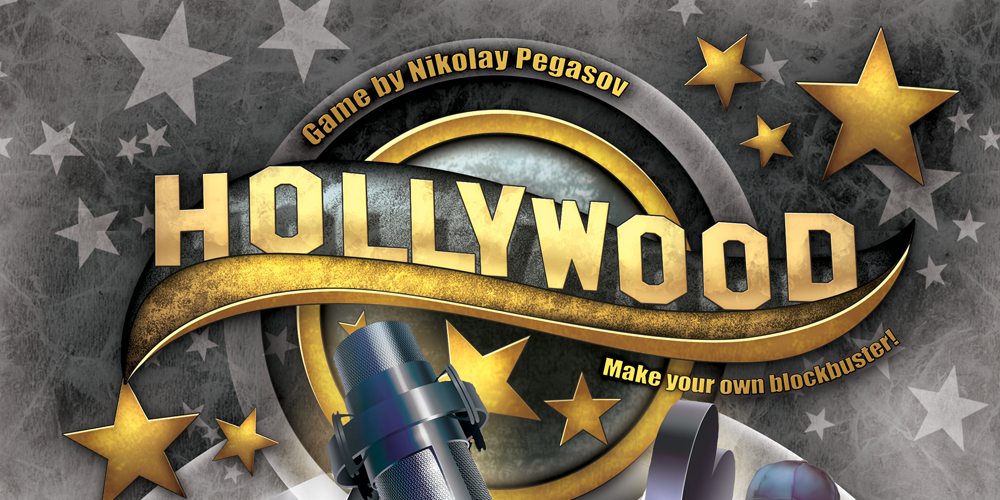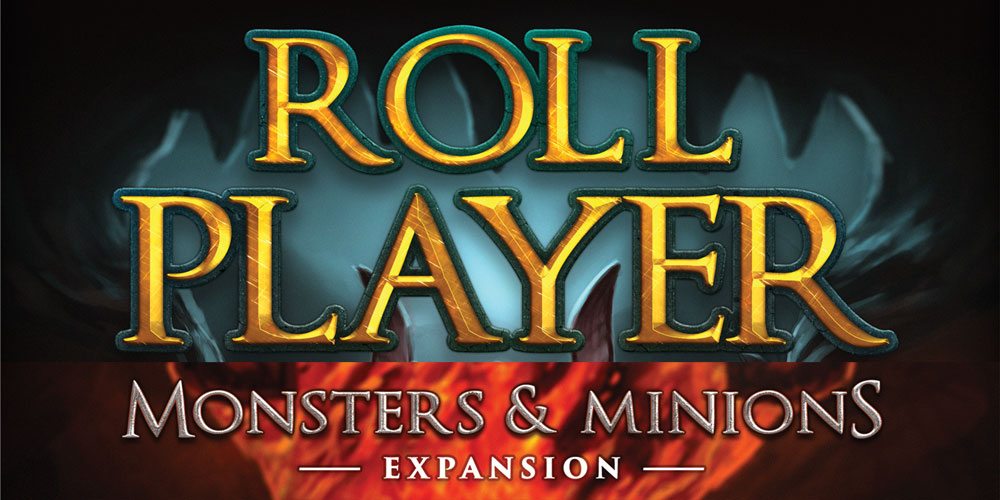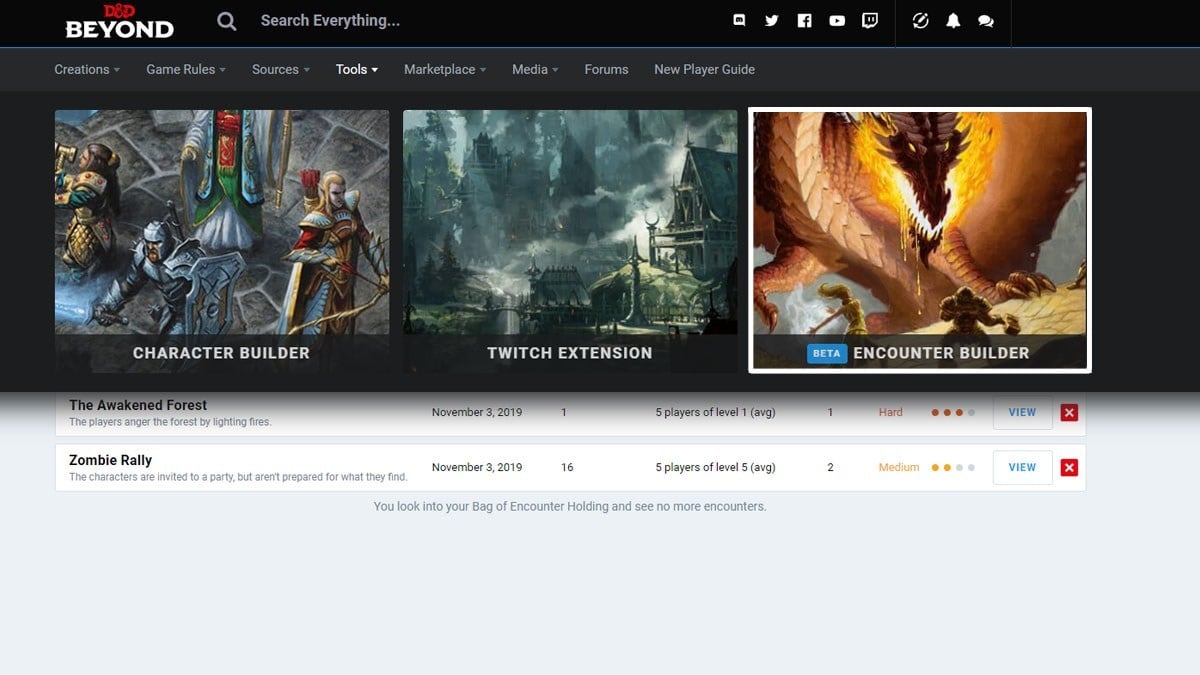Lights! Camera! Action! Put together your film crews and take your best shot at making this year’s blockbuster. Or maybe you’ll try to win the Best Picture award, which will make you some more money down the road. Will you put your versatile actor in a comedy or a thriller? Or is it time to dust off that worthless script from the archives and just slap together something on the cheap? Welcome to Hollywood.
At a glance: Hollywood is a board game for 3-6 players, ages 13 and up, and takes about 30 minutes to play, though play time depends heavily on how long players take to make decisions. (The first time you play, you should plan for closer to 45 minutes or an hour.) The European version of the game was published by Hobby World, which is now running a Kickstarter campaign to fund a US version—the basic pledge for a copy of the game is $40. There’s not really anything objectionable for younger players other than some cartoony cleavage (no wardrobe malfunctions, though). However, the mechanics include card drafting and auction bidding, plus you’ll need to do some quick arithmetic while putting together your movies, so younger players may have a harder time keeping up.
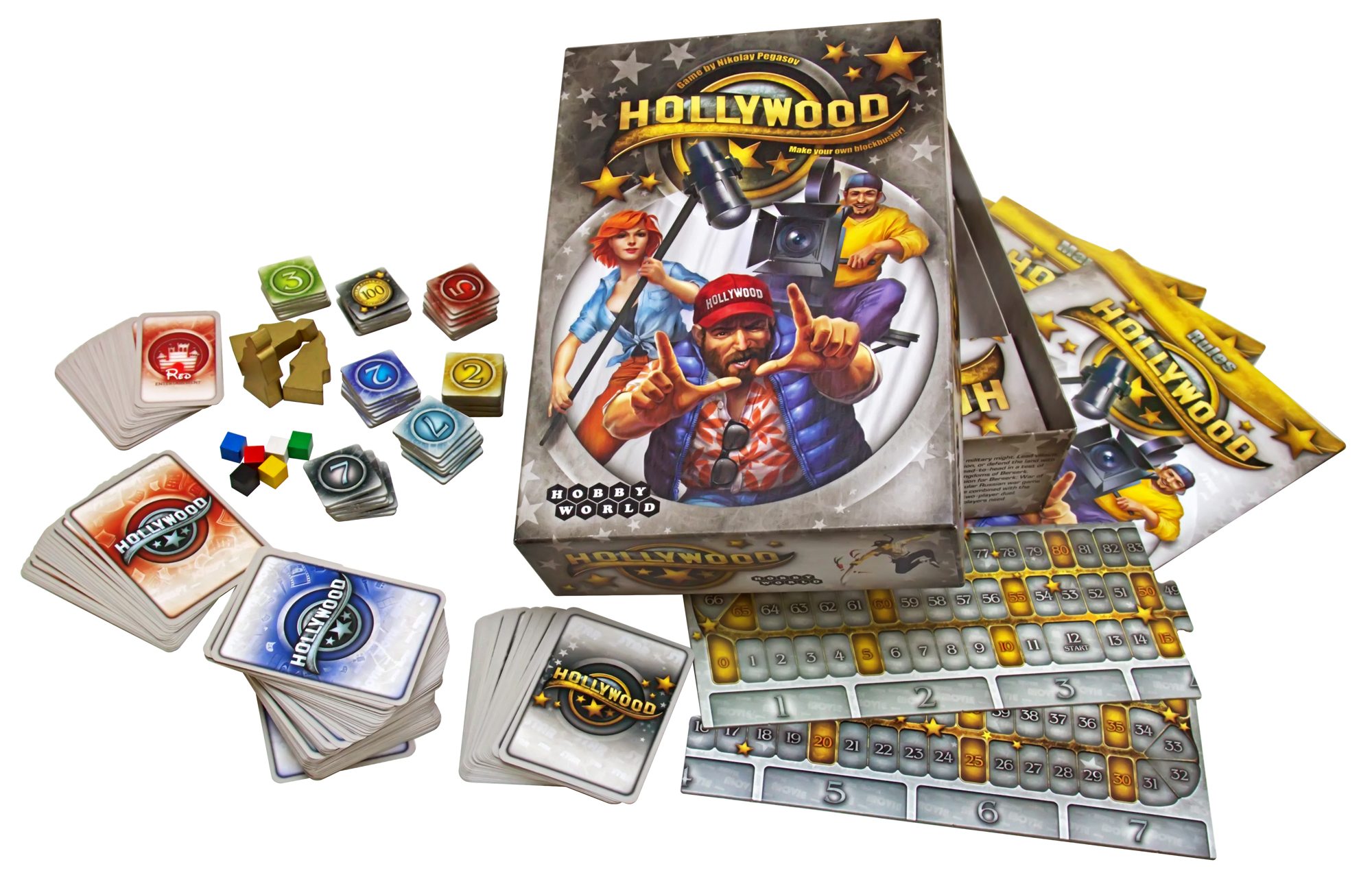
Components:
- 126 basic cards
- 36 Star cards
- 16 Worthless Script cards
- 30 Bidding cards (5 each in 6 player colors)
- 42 Auction tokens (7 each in 6 player colors)
- 6 100-million tokens
- 6 scoring markers (wooden cubes)
- 3 Hollywood Award figurines
- Score board
I was sent a copy of the international version (which has rules in English, German, and French) and the components are pretty good. The tokens and the scoreboard are all cardboard punch-outs, with the scoreboard as two pieces that notch together like a puzzle. The cards are okay, though not the highest quality—I don’t know if this will change depending on the Kickstarter funding. The bidding cards are half-sized and the rest of the cards are full-sized.
The box divider is made of somewhat flimsy cardboard and mine was a bit bent up; the box is actually a bit bigger than it needs to be for most of the components other than the scoreboard and the rulebook(s). One note is that since the rules have been translated from Russian, there are a few strange terms throughout, like “field for tallying up” instead of “scoreboard.” I don’t know if these will be changed in the US version.
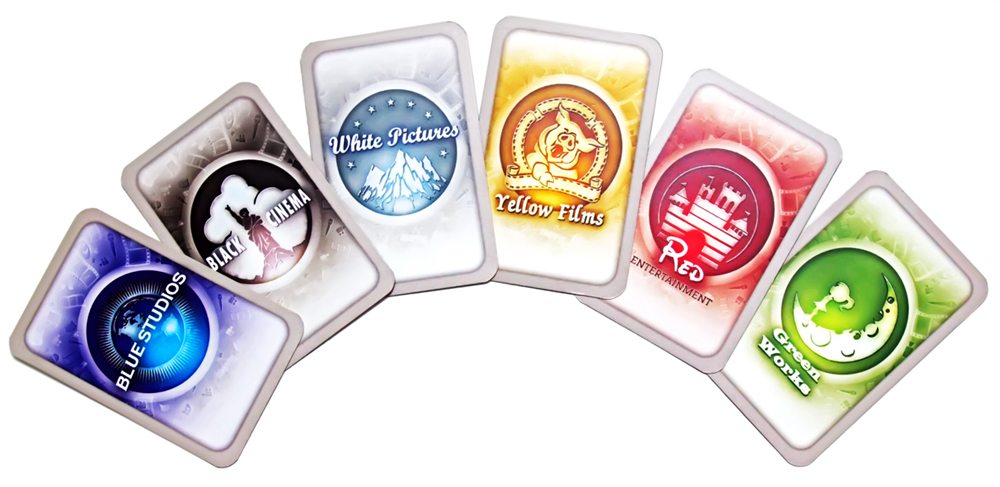
The artwork on the cards is pretty fun. Each player color represents a studio, and the bidding cards and tokens have little logos that are clearly inspired by real-world Hollywood studios. The people on the basic and star cards are done in a caricature style and it’s fun to guess who they’re based on: is that award-winning director Guillermo del Toro? With all of the parody art, I’m surprised the “Hollywood Award” figurines looked like hooded figures rather than the Oscars, but maybe they worried they couldn’t get away with that.
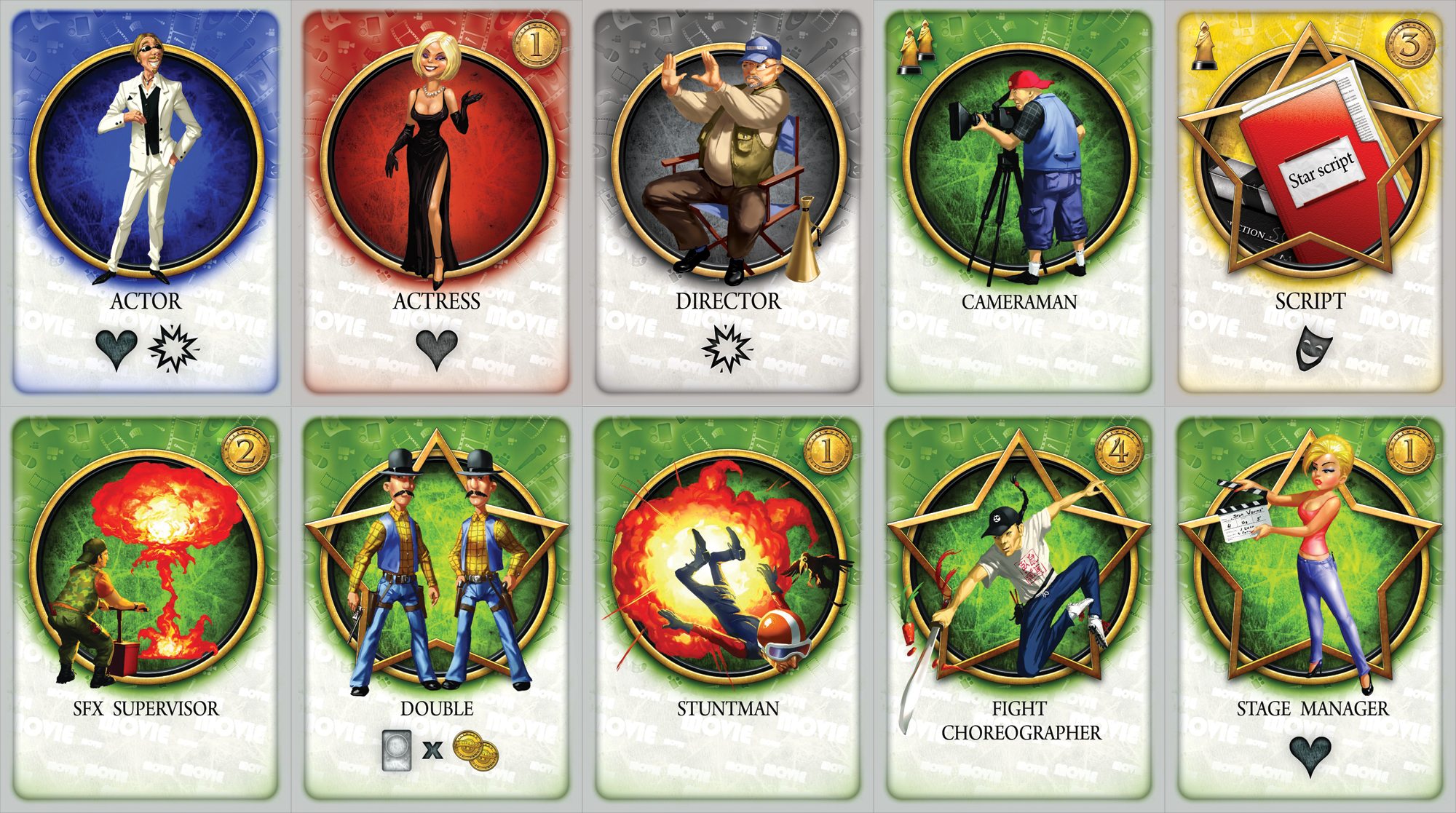
How to play:
If you prefer, you can download a copy of the rules here.
The goal of the game is to make the most money in three production years by assembling a crew to create films.
To setup, put the scoreboard in the center and the scoring markers on 12 million, which is both your score and your budget. Each player takes the bidding cards and auction tokens in their color. The Basic cards are shuffled together, and the Star cards are shuffled into a separate deck. The Worthless Script cards are placed to one side.
At the beginning of each round (which represents a year), each player gets 7 basic cards dealt to them. Then, you place as many Star cards as there are players below the scoring track (from left to right), placing the rest of the Star cards deck in the next slot.
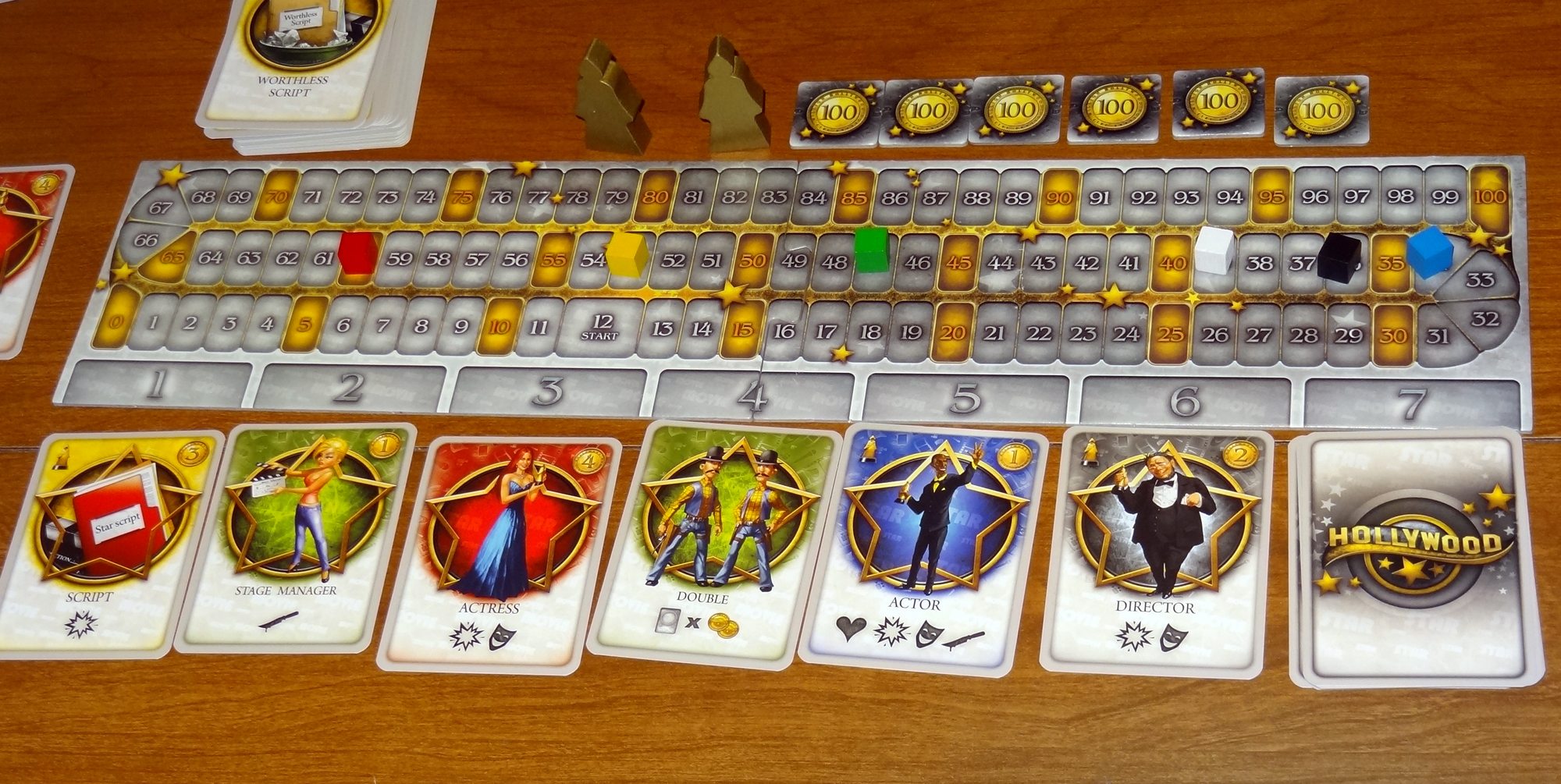
Next, each player will get one Star card from the deck. You can just deal these out randomly if you like, but the full rules let you compete for the honor of distributing them. The first year you do an auction, and in subsequent years the honor goes to whoever won the Hollywood Award for the previous year. That player will then get to draw the right number of Star cards, look at them, and choose one to give to each player.
After that, you draft the 7 basic cards in your hand. That means you pick one to keep, put it face-down in front of you, and then pass the rest. You’ll keep doing this with the cards you get passed until all the cards are taken. You’ll pass clockwise the first and third years, and counterclockwise the second year.
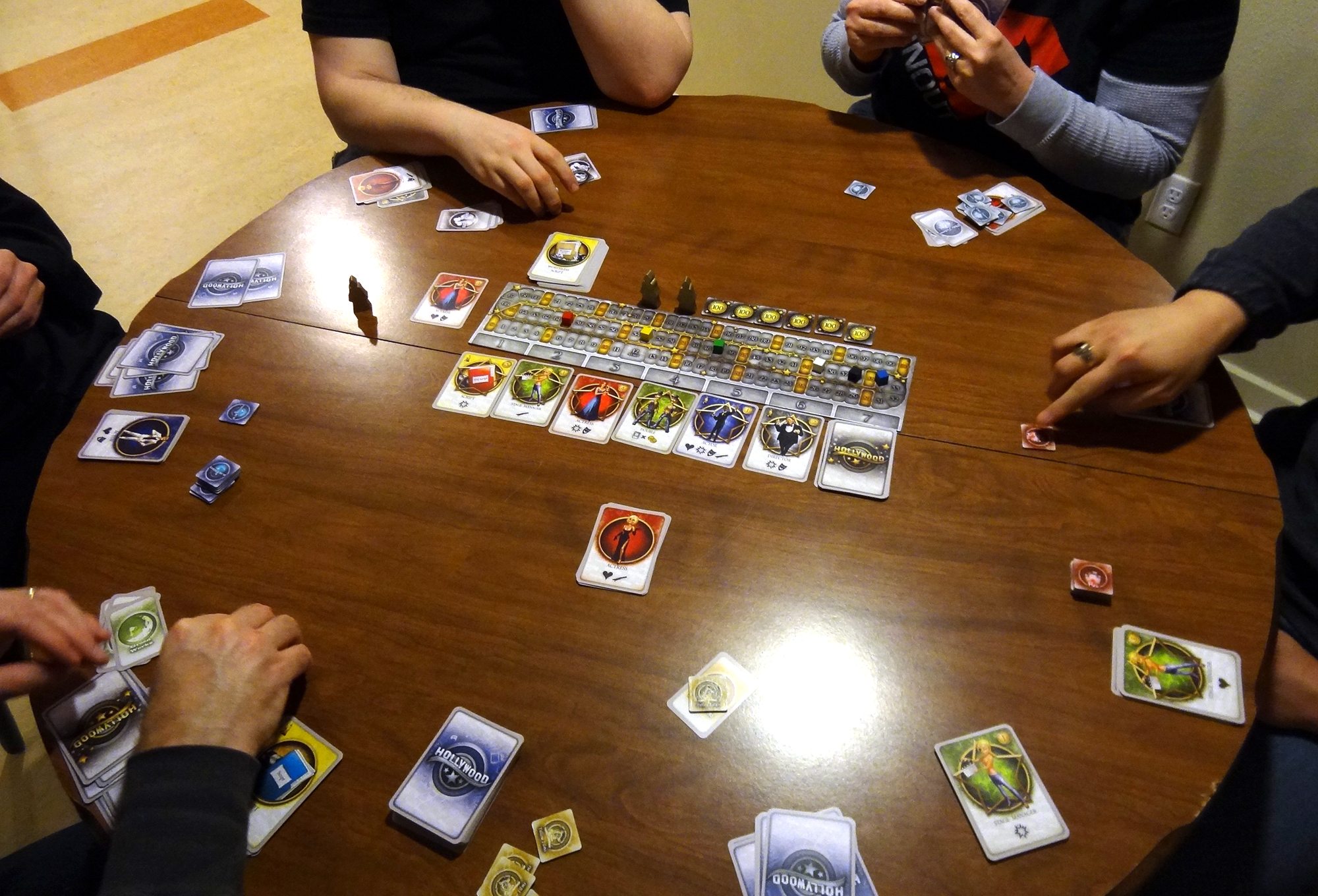
Then, there’s an auction for those Star cards below the scoreboard. You decide which card you want to bid on (including an unknown face-down card), and then how much you want to bid for it. The tokens are numbered 1 through 7, to show which card you’re bidding on, and the cards have amounts 1, 3, 6, 9, and 12. You must bid something unless you’re totally out of money.
Once everyone has selected a number and bid amount, all the tokens and amounts are revealed. Everyone has to pay the amount they bid, whether they won the auction or not. (That’s the one odd thing about this auction—even the losers have to pay.) If you have the highest bid on the card you choose, you take the card and are done with the auction. If you tied with somebody on the same card or had a lower bid, then once all the winners have taken their cards, you’ll bid again in a second round. The auction continues until each player has purchased one card (or run out of money). Note that only one player can win a face-down card each year.
There’s a brief pause for Crew Activities—in this set, that means the Agents come into play. Anyone with an Agent must play it, which allows to choose another player; the chosen player must select a director, actor, or actress from their hand to give to the player with the Agent.
Finally, it’s time to make your movies!

Now you take your 9 cards (the 7 basic cards you drafted, the 1 Star card you started with, and the Star card you bought at auction) and attempt to make some movies. Each movie must have at a minimum a script, a director, and either an actor or actress, so it takes at least 3 cards to make a movie, so at most you may make 3 small movies in a year if you have the right combinations, though generally you’ll get more money for bigger movies. At most a movie may have only one script, one director, and two actors/actresses, plus any number of green crew cards. You may also discard any number of cards to take Worthless Script cards from the pile.
Once everyone is happy with their movies, you go around and introduce your movie and score points (i.e., money). Here’s how you figure the value of your movie:
- Each card in the movie is worth 1 million.
- The icon on the Script determines the movie’s genre (action, comedy, thriller, romance)—and each icon is worth the total number of cards bearing that icon. So if your movie is a thriller and there are 3 cards with the “thriller” icon, then you get a total of 9 million for the genre. (If you have a Worthless Script, you get to choose the genre, but the script itself doesn’t have an icon on it.)
- If you have a Lead Duo (an Actor and an Actress), then add 4 million.
- If any of your cards have coins on the top corner, you add the value of the coins.
- Finally, you add any money gained from green Film Crew cards, which have various bonus abilities.
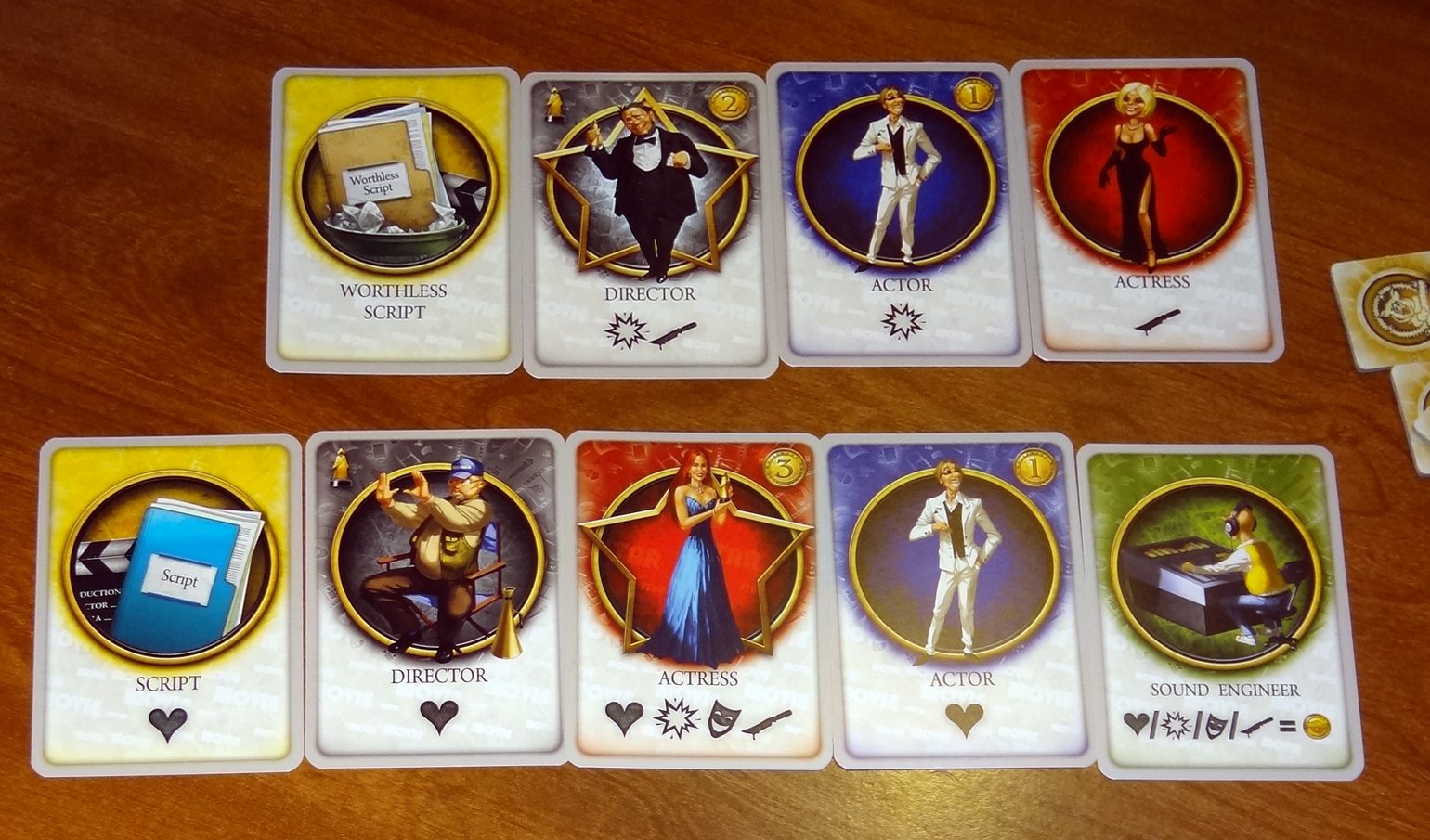
Finally, once everyone’s box office performance has been tallied up and recorded on the scoreboard, you see who wins the Film of the Year Award. Whoever has the most golden figurines on their cards for a single movie wins the award. If there’s a tie, the non-contenders get to vote for a winner.
All of your cards, even the ones that weren’t used in a movie, go into your own discard pile—these will matter at the end of the game.
After all three production years are over, there’s one last phase: extra box office earnings based on awards. Anyone who has won golden figurines counts up all of the figurines on the cards in their discard pile. Each figurine in the card is worth 1 million for each award that player has won. This represents additional earnings you’ll get for an award-winning movie.
Whoever has the most money at the end of the game wins. In case of a tie, the player with the most awards wins—and if those are the same, then there’s a tie for the win.
The Verdict
Hobby World, the publisher of Hollywood, is probably the foremost publisher and distributor of Eurogames in Russia—it also holds the license for games like Ticket to Ride, Settlers of Catan, Munchkin, and Carcassonne. But they have also been publishing their own game designs, and to me it’s fascinating to see games designed from a Russian perspective. Septikon, which successfully funded on Kickstarter earlier this year, had a decidedly Cold War feel to it. But when I heard about Hollywood, I knew I had to see how Russians think American movies are made.
Thematically, there are some things that seem to ring true and some that don’t: for instance, all of the genres in the game are equally likely to bring in the big bucks, but I’m not sure that’s necessarily true in real life. Plus, in the game you don’t need a bigger budget for special effects—you just have to manage to get the right crew member. (That, and you could have a romance flick with a fight choreographer, stunt doubles, and special effects.) The biggest difference between the game and reality may be that in the game, quite often the winner of the Hollywood Award is also one of the biggest box office successes—whereas the Best Picture nominees are often not the big moneymakers.
That said, there is a sort of logic to the game. If you’ve got a script for a thriller, you’ll make more money if you get a director and a cast who all specialize in thrillers, as opposed to putting in a couple of guys known for their comedic abilities.
When it comes to the mechanics of the game, the combination of drafting and bidding is pretty nice. You get the bulk of your cards from the draft, which evens out the luck factor and gives you a little more information about all the cards that are getting passed around. It helps you make a decision about what you might want to bid for, and you can start planning out what type of movie you might want to produce. The pay-even-if-you-lose is a little strange, but overall the auction is also a nice touch—like you’re getting into a bidding war for that famous actress or a really promising script.
Once you’re finally assembling your movies, it’s fun to imagine what they might be. One person put together a small romantic flick that only had an Actor and no Actress, but it had quite a few golden figurines… we figured that must be Her. Some players were better at coming up with titles than others: we had a thriller titled something like I Saw What You Did in the Cabin Last Summer 3.
Another great aspect of the game is that nearly everything takes place simultaneously, so there’s less downtime. At the beginning of each round if you’re waiting for one player to distribute the Star cards is one of the only times when you might not be doing anything. For the drafting, auction, and movie production phases, everyone is working at the same time, so the game goes pretty quickly once everyone knows the rules.
The end-game bonus for having awards can be a pretty big boost, particularly if you manage to win more than one award, but it can be hard to get a lot of figurines in a single movie. Sometimes, if you’re making more than one film, you have to decide between getting more money or trying to win that award—and I’ve had cases where I went for the award but lost, and should have just gotten a little more money by arranging my cards differently.
The Kickstarter project has a number of stretch goals that could add a few other cards to the mix, like the second-unit directors that can help you fill in a gap if you’re missing a director (at a cost, of course) or the PR Specialist who makes it easier for you to win the Hollywood Award. Keep an eye on the Kickstarter page for the status of these stretch goals.
Overall, I think the game has a good mix of luck vs. strategy, and it’s a fun theme to play around with. Even when your films aren’t making a lot of money, it can still be funny to give your flop a title and explain that, well, you really didn’t know how a remake of the live-action Inspector Gadget could go wrong, particularly with Denzel Washington playing the lead.
For more about Hollywood, check out the Kickstarter page!
Disclosure: GeekDad received a review copy of the international version of the game.
